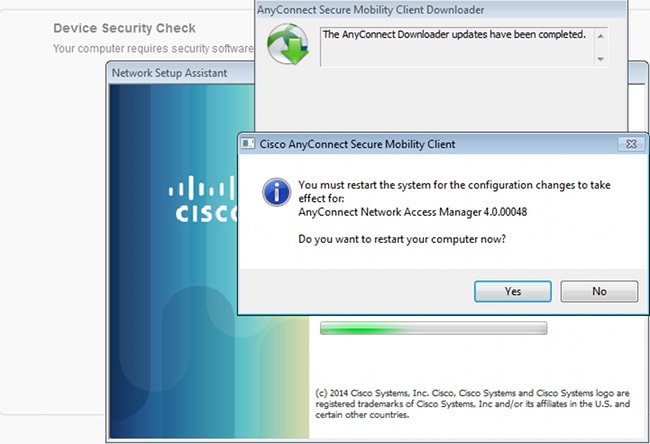Virtual Private Network (VPN) is a convenient way to access network-restricted resources on the campus network that would otherwise be unavailable from off campus. In some countries, access to the University’s VPN service may be limited or restricted. To connect to the BU VPN you'll need to install the Cisco AnyConnect Secure Mobility Client. For Medical Campus resource access, please see the BUMC VPN instructions.
Note: We no longer support built-in VPN programs on Mac or Windows, as they are incompatible with the Two-Factor VPN.
Apr 17, 2019 Cisco AnyConnect VPN for Windows VPNWinOTP.exe or VPNWinOTP.zip. Cisco AnyConnect VPN for Mac OSX anyconnect-macos-4.9.04043-predeploy-k9.dmg. Malware Bytes Client for MacMalwarebytes Client. Anyconnect-linux64-4.7.00136-predeploy-k9.tar.gz 25422086 anyconnect-linux64-4.7.00136-vpnapi.tar.gz 4408419 anyconnect-linux64-4.7.00136-webdeploy-k9.pkg 36450694 anyconnect-macos-4.7.00136-predeploy-k9.dmg 35428359 anyconnect-macos-4.7.00136-vpnapi.tar.gz 22067441 anyconnect-win-4.7.00136-core-vpn-lang-predeplo. 655101 anyconnect-win-4.7.
Mac OS X (10.12 and higher)
Goto https://vpn.bu.edu and login with your BU username and Kerberos password

Wait for the download link to appear (this will take a VERY LONG time for the page to fully load, especially on Chrome, this is a known issue and we suggest trying a different browser like Firefox or Safari first) and click 'Download for macOS'
Once the file is completely downloaded, click open the .dmg file, it will automatically mount on your desktop as a disk named AnyConnect VPN 4.7.01076. Open this disk and launch the installer called Anyconnect-macos-4.7.01076-core-vpn-webdeploy-k9.dmg. The installer will require that you have administrative access to the machine.
Ensure that you have an active network connection. You must have an active network connection in order for the VPN client to connect.
Launch the Cisco AnyConnect Client, which is located in /Applications/Cisco.
Cisco AnyConnect VPN for Windows VPNWinOTP.exe or VPNWinOTP.zip. Cisco AnyConnect VPN for Mac OSX anyconnect-macos-4.9.04043-predeploy-k9.dmg. Malware Bytes Client for MacMalwarebytes Client. OSX - anyconnect-macos-4.8.02042-predeploy-k9.dmg Windows - anyconnect-win-4.7.00136-core-vpn-predeploy-k9.msi Linux - anyconnect-linux64-4.7.00136-predeploy-k9.tar.gz. To connect to Cisco AnyConnect follow the instructions in Connect to AnyConnect VPN for Mac OS X. Installing Cisco AnyConnect for macOS. Click on the Download button under the AnyConnect for macOS (Recommended) section on the Downloads & Guides page. Enter your Internet ID and password, if prompted. Save the application, Do Not Run from the web. Windows anyconnect-win-version-webdeploy-k9.pkg macOS anyconnect-macos-version-webdeploy-k9.pkg Linux(64-bit) anyconnect-linux64-version-webdeploy-k9.pkg AnyConnect Package Filenames for Predeployment OS AnyConnect Predeploy Package Name Windows anyconnect-win-version-predeploy-k9.zip macOS anyconnect-macos-version-predeploy-k9.dmg. Anyconnect-win-4.7.04056-predeploy-k9.zip 39052238 anyconnect-macos-4.7.04056-predeploy-k9.dmg 38903893 anyconnect-linux64-4.7.04056-webdeploy-k9.pkg 37377756.
In the connect to: field enter : vpn.bu.edu
- Next, click Select. The client will connect, and you will be prompted for your BU login name
and Kerberos password. - You may close the window, but not quit the application for the duration of your session. When you have finished using the connection, click Disconnect in the top right menu bar.
Anyconnect Macos 4.7 01076 Predeploy K9 Dmg Security
Windows (10, 8.1, 8 , 7)
Goto https://vpn.bu.edu and login with your BU username and Kerberos password
Anyconnect Macos 4.7 01076 Predeploy K9 Dmg Download
Wait for the download link to appear (this may take some time for the page to fully load) and click 'Download for Windows'
Once the file is completely downloaded, click open the .exe file, to launch the installer called anyconnect-win-4.7.01076-core-vpn-webdeploy-k9.exe. The installer will require that you have administrative access to the machine.
After the installation is complete, you should restart your computer — especially if you are upgrading from an older version of the AnyConnect Secure Mobility Client.
Ensure that you have an active network connection. You must have an active network connection in order for the VPN client to connect.
Launch the Cisco AnyConnect Client, which is located in Start > All Programs > Cisco > Cisco AnyConnect Secure Mobility Client.
In the VPN: field enter : vpn.bu.edu

Next, click Connect. The client will connect, and you will be prompted for your BU login name and Kerberos password.
You may close the window, but not quit the application for the duration of your session. When you have finished using the connection, click on the icon in the bottom left menu bar then click Disconnect.
iOS Device (iPhone, iPad)

- Download the Cisco AnyConnect Secure Mobility Client from the App Store on your iPhone.
- Once the application is installed, run the client to set up a connection. Click Add VPN Connection, use the following information when prompted, and then click Save.
- Description: BU VPN
- Server Address: vpn.bu.edu
- NetworkRoaming: ON
- Certificate: Automatic
- Connecton Demand : OFF
- Next, slide the AnyConnect VPN from OFF to ON and then use your BU login name and Kerberos password to log in.
Android Device (4.0 and above)
- Download the Cisco AnyConnect Secure Mobility Client from the Google Play Store on the Android Device.
- Once the application is installed, run the client to set up a connection. Click Add VPN Connection, use the following information when prompted, and then click Done.
- Description: BU VPN
- Server Address: vpn.bu.edu
- Certificate: Automatic
- Next, click the AnyConnect VPN on the main page and then use your BU login name and Kerberos password to log in.